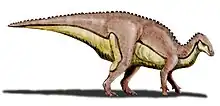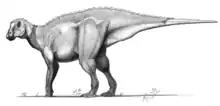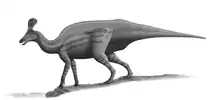| Saurolophines Temporal range: Late Cretaceous, | |
|---|---|
 | |
| Fossil mount of Edmontosaurus | |
| Scientific classification | |
| Domain: | Eukaryota |
| Kingdom: | Animalia |
| Phylum: | Chordata |
| Clade: | Dinosauria |
| Clade: | †Ornithischia |
| Clade: | †Ornithopoda |
| Family: | †Hadrosauridae |
| Clade: | †Euhadrosauria |
| Subfamily: | †Saurolophinae Lambe, 1918 |
| Type species | |
| †Saurolophus osborni Brown, 1912 | |
| Tribes and genera[1] | |
Saurolophinae is a subfamily of hadrosaurid dinosaurs. It has since the mid-20th century generally been called the Hadrosaurinae, a group of largely non-crested hadrosaurs related to the crested sub-family Lambeosaurinae. However, the name Hadrosaurinae is based on the genus Hadrosaurus which was found in more recent studies to be more primitive than either lambeosaurines or other traditional "hadrosaurines", like Edmontosaurus and Saurolophus. As a result of this, the name Hadrosaurinae was dropped or restricted to Hadrosaurus alone, and the subfamily comprising the traditional "hadrosaurines" was renamed the Saurolophinae.[1] Recent phylogenetic work by Hai Xing indicates that Hadrosaurus is placed within the monophyletic group containing all non-lambeosaurine hadrosaurids.[2] Under this view, the traditional Hadrosaurinae is resurrected, with the Hadrosauridae being divided into two clades: Hadrosaurinae and Lambeosaurinae.
Saurolophinae was first defined as a clade in a 2010 phylogenetic analysis by Prieto-Márquez.[3] Traditionally, the "crestless" branch of the family Hadrosauridae had been named Hadrosaurinae. However, the use of the term Hadrosaurinae was questioned in a comprehensive study of hadrosaurid relationships by Albert Prieto-Márquez in 2010. Prieto-Márquez noted that, though the name Hadrosaurinae had been used for the clade of mostly crestless hadrosaurids by nearly all previous studies, its type species, Hadrosaurus foulkii, has almost always been excluded from the clade that bears its name, in violation of the rules for naming animals set out by the ICZN. Prieto-Márquez (2010) defined Hadrosaurinae as only the lineage containing H. foulkii, and used the name Saurolophinae instead for the traditional grouping.[3]
The cladogram below follows Godefroit et al. (2012) analysis.[4]
| |||||||||||||||||||||||||||||||||||||||||||||||||||||||||||||||||||||||||||||||||||||||||||||||||||||||||||||
The following cladogram was recovered in the 2013 phylogenetic analysis by Prieto-Márquez (the relationships within Lambeosaurinae and between basal hadrosauroids aren't shown).[1]
| |||||||||||||||||||||||||||||||||||||||||||||||||||||||||||||||||||||||||||||||||||||||||||||||||||||||||||||||||||||||||||||||||||||||||||||||||||||||
In a 2023 study, Alarcón-Muñoz et al. implemented an updated version of the phylogenetic matrix of Rozadilla et al. (2022) to analyze the relationships of saurolophines and hadrosaurids. They proposed the name Austrokritosauria for the clade of entirely South American saurolophines closely related to kritosaurins. The results of their phylogenetic analyses of Saurolophinae are displayed in the cladogram below.[5]
| Saurolophinae |
| ||||||||||||||||||||||||||||||||||||||||||||||||||||||||||||||||||||||||||||||||||||||||||||||||||||||||||||||||||||||||||||||||||||
See also
References
- 1 2 3 Prieto-Márquez, A. (2013). "Skeletal morphology of Kritosaurus navajovius (Dinosauria:Hadrosauridae) from the Late Cretaceous of the North American south-west, with an evaluation of the phylogenetic systematics and biogeography of Kritosaurini". Journal of Systematic Palaeontology. 12 (2): 133–175. doi:10.1080/14772019.2013.770417. S2CID 84942579.
- ↑ Xing, H.; Wang, D.; Han, F.; Sullivan, C.; Ma, Q.; He, Y.; Hone, D. W. E.; Yan, R.; Du, F.; Xu, X. (2014). "A New Basal Hadrosauroid Dinosaur (Dinosauria: Ornithopoda) with Transitional Features from the Late Cretaceous of Henan Province, China". PLOS ONE. 9 (6): e98821. doi:10.1371/journal.pone.0098821. PMC 4047018. PMID 24901454.
- 1 2 Prieto-Márquez, A. (2010). "Global phylogeny of Hadrosauridae (Dinosauria: Ornithopoda) using parsimony and Bayesian methods". Zoological Journal of the Linnean Society. 159 (2): 435–502. doi:10.1111/j.1096-3642.2009.00617.x.
- ↑ Godefroit, P.; Bolotsky, Y. L.; Lauters, P. (2012). "A New Saurolophine Dinosaur from the Latest Cretaceous of Far Eastern Russia". PLOS ONE. 7 (5): e36849. doi:10.1371/journal.pone.0036849. PMC 3364265. PMID 22666331.
- ↑ Alarcón-Muñoz, Jhonatan; Vargas, Alexander O.; Püschel, Hans P.; Soto-Acuña, Sergio; Manríquez, Leslie; Leppe, Marcelo; Kaluza, Jonatan; Milla, Verónica; Gutstein, Carolina S.; Palma-Liberona, José; Stinnesbeck, Wolfgang; Frey, Eberhard; Pino, Juan Pablo; Bajor, Dániel; Núñez, Elaine; Ortiz, Héctor; Rubilar-Rogers, David; Cruzado-Caballero, Penélope (2023-06-16). "Relict duck-billed dinosaurs survived into the last age of the dinosaurs in subantarctic Chile". Science Advances. 9 (24). doi:10.1126/sciadv.adg2456. ISSN 2375-2548. PMC 10275600.







